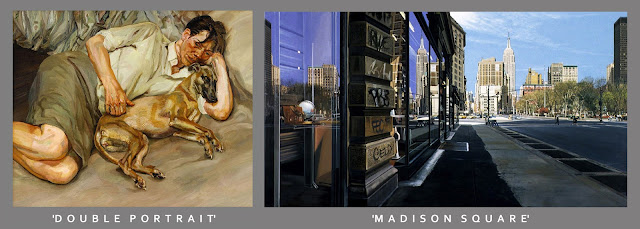#ArtIsEverywhere: Artists of the Quarantine (My NDTV-Mojarto Column)
PEOPLE ARE POSTING PICTURES and videos of sparrows on their balconies. Nilgais walking around mall complexes. And civet cats crossing the road. Strange things are happening in this time of a national lockdown. It is a situation that no one could’ve prepared for. Except perhaps Noah, the antediluvian Biblical character. It is an unprecedented situation that few could have prepared for. Food one can stock up. But what about food and stimulation for the mind! The mind is, after all, a wandering creature that unlike the stomach craves for newer experiences all the time. And especially so when it is confined to a physical space.
Here I think art comes to the rescue. Since most artists work from the silence of their studios. The process of applying stroke upon stroke of paint on a canvas is a not the unthinking act of a wall painter. To the artist it means hours and hours of reflection and stepping back to see how it is all coming together.
That’s why a painting has the power to speak in a language that is both visual and visionary. Unlike a film or a video where images change in rapid succession, a painting is a single image that does not move. This makes it incumbent upon the viewer to look and look again to keep finding meaning in it. And then perhaps reflect upon the many meanings extracted from the work. It is in many ways akin to a religious experience that leaves the believer with many layers of experience days, weeks, months and years after it has been seen and felt.

For this column I have selected six paintings that I have been viewing since the lockdown began and they have helped me immensely in understanding urban ennui especially in a situation of confinement. The first is Edward Hopper’s ‘The Chair Car’. It is a work situated inside an American rail coach where four people are seated singly. They are all ‘alone together’ travelling to their destinations eager to avoid eye-contact with each other, perhaps because they know they may never see each other again. The only exception is a woman who is looking at another woman reading a book. Hopper is like no other artist when it comes to showing the remarkable disconnect of urban spaces.
The second painting is a ‘Double Portrait’ by Lucian Freud. It is of a pensive-looking woman lying with her dog. The dog’s head is resting on her arm while her other hand is absent-mindedly touching the dog’s back. It is a tender moment between pet and pet-parent that many of us have felt with our pets who give us comfort knowing almost instinctively when we’re down and out. Such tenderness has rarely been portrayed between humans and animals and Lucian Freud—a grandson of Sigmund Freud—is a master at showing it.

I have a special place in my heart for the large-headed portraits of Francesco Clemente but his ‘Gita Mehta’ is a class apart. Clemente, who has spent years in various parts of India has captured Mehta, the writer, with brilliant perfection. The slightly creased forehead of a woman with a bindi is no ordinary woman. She is an acclaimed writer—the first Indian who explained the Hippie fascination with India—and who often lives inside her mind walking the tightrope between logic and imagination.
‘Barber Shop’ by Bhupen Khakhar is next on my list. The artist who was perhaps the first in India to be openly gay and whose art often tackles the issue of sexual identity is also remarkable in his study of small personal spaces. The painting is a stunning portrayal of urban self-reflection where the barber and his mirror together gave you insights about yourself and the world as conversations spilled beyond the realm of hair and grooming.

Richard Estes’ near perfect photo-realism produced many gems of American urban life as seen or imagined on ‘vacant and quiet Sunday mornings’. However his ‘Madison Square’ (made in 1994) is almost prescient as it shows this part of New York as it is now: absolutely vacant and absolutely quiet as the city struggles to cope with the highest number of cases of Covid-19 in the USA. Estes stunning portrayal of urban America is unique as it often has the power to spook you completely.
The last in my list is German artist Michael Sowa’s ‘Sharks of Suburbia’ in which a flooded street is packed with menacing-looking sharks. It could be dusk, or dawn and a lone man is peeping from his first-floor window. It is perhaps a vision only he can see which explains the lack of alarm or shock on his face. Sowa is again a master at showing us how loneliness affects us as we work our way through the concrete jungle where we are surrounded by people yet are terribly and awesomely alone.
Dhiraj Singh is a well-known journalist, writer, TV personality and artist who has shown his abstract paintings and X-Ray works in India and abroad. He is also a co-founder of Hunar TV, a web channel for the arts. More about him can be found at https://dhirajsinghart.blogspot.com/
Article link on NDTV-Mojarto is HERE


Comments
Post a Comment